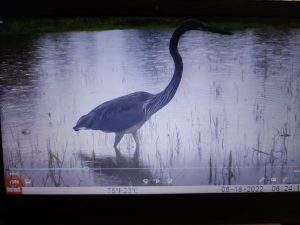 Phibsoo Wildlife Sanctuary with support from Bhutan For Life has created artificial waterholes, one of which includes Khartsho artificial waterhole. The waterhole is created as a means of water provision to the wildlife especially during the dry season.
Phibsoo Wildlife Sanctuary with support from Bhutan For Life has created artificial waterholes, one of which includes Khartsho artificial waterhole. The waterhole is created as a means of water provision to the wildlife especially during the dry season.
The park have placed camera traps basically to monitor the diversity of wildlife using the artificial waterholes. The camera traps has revealed that lots of wildlife species was using the waterhole for drinking, mud bath and for various other purposes.
However, what stunned the park officials was even the rare White-bellied Heron (WBH) was captured using the waterhole. The park official captured a lone WBH using the Khartsho artificial waterhole. Even more encouraging was that the WBH was captured feeding in the waterhole.
The fishes are known to fill the waterhole when the river floods in summer. These fishes thrive in the artificial waterhole, which in turn provides as source of food for WBH. This indicates artificial waterhole can be effective not just for the overall wildlife but even to a critically endangered species such as WBH. That when habitat destruction due to human interference is attributed as one of the reasons for decline in WBH population, restoration or creation of alternate or artificial feeding ground can help save WBH.
PWS has recorded three WBH since 2014. WBH site assessment and Habitat Inventory carried out by PWS within their territory states that the WBH in PWS were basically observed in two stations i.e in Phibsoo and Nichula range.
White-bellied Heron (WBH), (Ardea insignis Hume, 1878) is the world’s second-largest Heron. It is categorized as critically endangered in IUCN species red list (IUCN, 2022) and is the rarest heron in the world. The global population initially was assumed to be fewer than 200 mature individuals (Wilson & Eames, 2006). In 2015, WBH international workshop held in Bhutan reported less than 60 individuals among four range countries of India, Myanmar, Bhutan and China.
RSPN annual WBH population count undertaken together with the Department has recorded 22 individuals in the wild.
![]()

